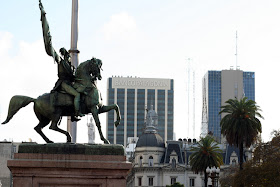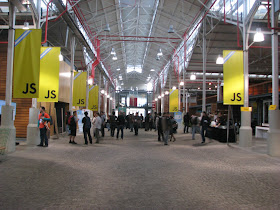The highlight of our trip to Mendoza was a full-day wine tour of the Luján de Cuyo region. We visited four wineries and tasted 19 (!) different wines. We also learned a lot about wine along the way.
ALTA VISTA
The first stop on our trip was the
Alta Vista winery, owned by the French d'Aulan family and the biggest of the wineries we visited. It was founded in the late 1800s by a Spanish family and bought by the d'Aulans in 1997.
The winery processes grapes from three different vineyards across the country: one on the main estate, one in the higher-altitude Uco Valley about 75 kilometers south, and one up north in Cafayate, known for the uniquely Argentine Torrontes grape. Wines from the Luján de Cuyo region tend to be aromatic and fruity, whereas those from Uco Valley have a more mineral and earthy flavor.
Two fun facts we learned from our tour guide:

1. In Argentina it's actually illegal to add sugar during the wine-making process. Because the climate in Mendoza is so dry, the grapes naturally have a high sugar content, which leads to a higher alcohol content (usually between 13 and 14.5 percent).
2. Decades ago, the average Argentine drank about 140 bottles of wine per year, and that number is calculated by including all the babies and children in the population. Basically, one hundred years ago, Argentines drank
a lot. And to keep up with all the demand, wineries focused on quantity over quality.
Now on to the wine tasting:
Torrontes Premium: The grapes for this wine are grown at 1700 meters at the vineyard in
Cafayate. They are harvested at three different times and then blended together. The wine smells sweet, with notes of pear and peach, but is dry in the mouth. For that reason, the winery refers to it as a "mentirosa," or liar. It's good paired with spicy foods.
Bonarda Premium: The Bonarda grape is most commonly seen in blends, but in this case it's used as a varietal. Half of the grapes are aged in concrete tanks and half in oak barrels. It's light to the taste and pairs well with pasta and other Italian foods.
Malbec Single Vineyard 2007: Alta Vista has three levels of wine: Premium, the lowest level; Single Vineyard, the next level up; and Alto, the top of the line. This Malbec is produced in small quantities and isn't exported. The grapes are grown at the Temis Vineyard in Uco Valley and spend 1.5 years in oak barrels before being bottled. The wine's aging potential is 13 years. Our guide, who is a professionally-trained sommelier, said he thought it's one of the best-value wines on the market.
Alto 2007: The top of the line, this wine is 70 percent Malbec and 30 percent Cabernet Sauvignon. The grapes ferment for 40 days, then spend 1.5 years in oak and then 1.5 years in the bottle, where they need to be turned evenly everyday. The aging potential is 15-20 years and the wine retails for about 550 pesos ($125).
Temporal: An extra brut sparking wine that is 95 percent Pinot Noir and 5 percent Chardonnay. The wine spends only a couple of hours in contact with the grape skins, just enough to give it a pinkish coloring.
PULENTA ESTATE
Bodega Pulenta Estate was founded in 2002, by the sons of Antonio Pulenta, who for decades owned Bodegas Trapiche, the country's largest wine producer. Pulenta Estate has a much more modern feel than Alta Vista and a smaller level of production. Its main export markets are the US, UK and Brazil.
Both Alta Vista and Pulenta Estate ferment their wine in thick concrete tanks, which help keep the temperature constant. After fermentation, the wines are moved by gravity to oak barrels (the more expensive wines at least, the less expensive ones are often unoaked). Most of the oak barrels are French-made, and a small percentage are American. American oak has larger pores than French oak, which tends to lead to more intense flavors.
The wine tastings:
 La Flor Sauvignon Blanc 2011
La Flor Sauvignon Blanc 2011: This is their bottom-level wine. It has a strong citrus flavor, and like the Torrontes at Alta Vista, its grapes are picked at three different points during the harvest season to obtain a balance between citrusy flavors and acidity.
Pulenta Estate Merlot 2007: This acidic wine is good with food, and particularly with creamy cheeses, like blue cheese.
Pulenta Estate is their second-tier wine, above
La Flor and below
Gran Pulenta. It spends 12 months in second-use French oak barrels. The vineyards import the barrels from France for about 1500 euros apiece. The top-quality wines are placed in the new barrels, which can be reused in future years, usually for progressively lower quality wines. After the fourth use, the vineyards resell the barrels in their gift shops for about 150 pesos ($35). Ben wanted to bring one home, but at about 75 kilos, it would probably exceed the airline weight limits.
Pulenta Estate Malbec-Cabernet 2009: The Malbec-Cabernet is a common blend to find in Buenos Aires. The Malbec, which makes up 60 percent, is sweet while the Cabernet is spicy, giving it a nice balance and making it a good wine to pair with traditional Argentine foods.
Gran Pulenta Cabernet Franc: This is easily the most unusual wine we tasted on our trip. If you can find it in the U.S., it might be worth buying just for the experience of smelling and tasting it, because the main aroma is ... green bell peppers. Cabernet Franc is common in blends, but isn't usually used as a single varietal. It requires a lot of monitoring during the growing process and spends a long time in oak to soften the flavors.
BODEGA CAELUM
The family-run Bodega Caelum was the newest winery we visited, with its first harvest completed in 2009. The family had previously used the land to grow pistachios and grapes, which it then sold to other wineries. In 2009, they decided to get involved in the wine-making part of the process. It's still a very small winery that's just starting to sell in Buenos Aires.
Caelum Rosado: A wine that's meant for easy drinking, it's a 50-50 blend of Malbec and Cabernet Sauvignon. The juice spends only three hours in contact with the grape skins to give it a little bit of color. Good as an appetizer.
Caelum Chardonnay: This is an unoaked Chardonnay, which takes only six months to reach the bottling phase. The wine spends no time at all in oak, which gives it a more fruity flavor of banana, pear and citrus.
Caelum Reserva Cabernet 2009: This wine is from their first vintage. It ferments for 30 days, is decanted in stainless steel tanks (unlike the first two vineyards, Caelum uses only stainless steel, not cement) and spends 15 months in oak barrels. It has an intense, purplish color and firm tannins. Tannins are a chemical compound found in grape skins and seeds. The chemical makeup of the tannins changes during the wine-making process and the tannins contribute to the astringency and bitterness of red wines. The idea is that as a wine ages, the tannins mellow.
Caelum Dolce: Our favorite wine of the trip, and the only one we bought. It's a dessert Malbec and unlike any other wine I've ever had. It uses good quality acidic grapes, which are harvested and then left to dry for 25-30 days, before aging in oak barrels for 10 months. This dehydration process increases the sugar content and means that it take a lot more grapes to make even a small bottle of this sweet wine, as compared to a traditional dry wine. We can't wait to drink our bottle, but first we have to find a dessert that is worthy of going along with it.
RUCA MALEN
Our final stop, whose name means "House of the Young Lady," in the indigenous Mapuche language. We didn't learn much about the winemaking process at Ruca Malen, instead we enjoyed a five-course gourmet meal with wine pairings as we looked out over the vineyards.
Yauquén Chardonnary 2010: An intense, unoaked Chardonnay. Paired with quinoa, white beans and green apple salad.
Yauquén Malbec-Cabernet Sauvignon 2011: A 50-50 blend where the two varieties are elaborated separately. Thirty percent of the wines are aged in oak barrels for six months, then everything is blended together. A fresh, fruity wine with high acidity that's good for cleaning the palate. Paired with leek, onion and bacon soup.
Ruca Malen Cabernet Sauvignon 2008: Aged 12 months in oak barrels — 80 percent French and 20 percent American. This is an intense and juicy wine with sweet and elegant tannins. Paired with iron-burned tomato and goat cheese on a pumpkin terrine.
Ruca Malen Reserva de Bodega 2009: 40 percent Cabernet Sauvignon, 28 percent Syrah, 22 percent Malbec and 10 percent Petit Verdot. The four wines are elaborated separately and aged 14 months in oak barrels. Then all the separate wines are tasted, combined into the final blend, bottled, and aged in the bottle for another year. Paired with a grilled beef tenderloin medallion with Malbec pomace butter.
Kinién Malbec 2008: Their best Malbec, aged 18 months in new oak barrels and then aged at least another 18 months in the bottle. Also paired with the beef tenderloin.
We had a fantastic day and can't say enough good things about the tour, which was run by
Ampora Wine Tours. We signed up for the group tour, but got lucky and it was just the two of us, our guide and a driver. Our guide was a trained sommelier who spoke perfect English and we enjoyed private tours and tastings at each of the wineries. It's pricey, but well worth it, and a million times better than the self-guided tour we did the next day in Maipu. If you are ever in Mendoza, take their tour. You won't regret it (we owe our friends Sean and Katie a big thanks for recommending Ampora to us).
- Steph






















































